If you’re considering growing orchids, you’ll quickly discover there’s a perfect variety for every skill level. While beginners often succeed with the forgiving Moth Orchid’s long-lasting blooms, experienced growers can tackle challenges like the Dancing Lady’s precise humidity needs or the Elegant Cattleya’s specific temperature requirements. From easy-care favorites to rare specimens, these 15 orchid varieties will take you from novice to expert status.
Contents
- 1 1. Moth Orchid for Beginners
- 2 2. Noble Dendrobium Orchid
- 3 3. Dancing Lady Orchid
- 4 4. Elegant Cattleya Orchid
- 5 5. Lady Slipper Pink Orchid
- 6 6. Fragrant Spider Orchid
- 7 7. Vanda Blue Magic Orchid
- 8 8. Dragon Mouth Orchid
- 9 9. Jewel Orchid’s Velvet Leaves
- 10 10. Miniature Masdevallia Orchid Blooms
- 11 11. Bamboo Orchid’s Narrow Stems
- 12 12. Gold Cup Orchid
- 13 13. Orange Butterfly Orchid
- 14 14. Variegated Vanilla Orchid
- 15 15. Miltonia Sunset Orchid
1. Moth Orchid for Beginners
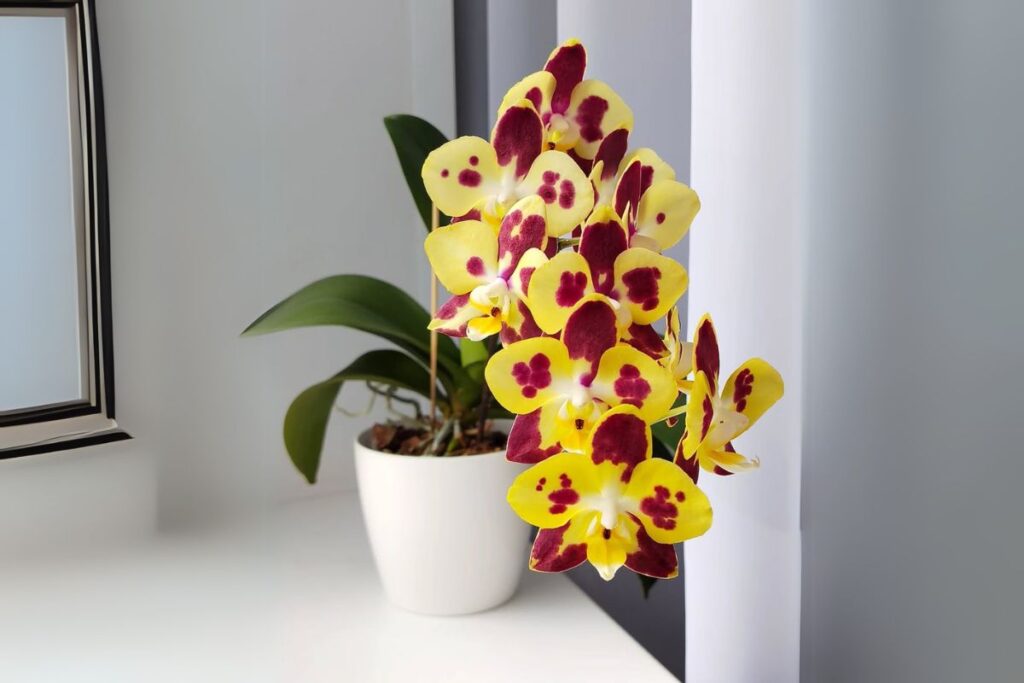
The Moth Orchid (Phalaenopsis) is widely considered the perfect orchid for beginners due to its forgiving nature and long-lasting blooms. These elegant plants feature thick, leathery leaves and produce arching stems with clusters of delicate flowers that can bloom for several months. Their nickname comes from their wing-shaped flowers that resemble moths in flight, and they’re available in various colors including white, pink, purple, and yellow.
- Light: Bright, indirect light; avoid direct sunlight which can burn leaves
- Temperature: 65-85°F (18-29°C); can tolerate normal household temperatures
- Humidity: 50-70%; benefits from regular misting or humidity tray
- Water: Water thoroughly when potting medium feels dry to touch; avoid overwatering
- Soil: Well-draining orchid mix with bark, charcoal, and perlite
- Fertilizer: Balanced orchid fertilizer every 2-4 weeks during growing season
- Potting: Repot every 1-2 years in fresh orchid mix
- Container: Clear plastic pots recommended to monitor root health
2. Noble Dendrobium Orchid
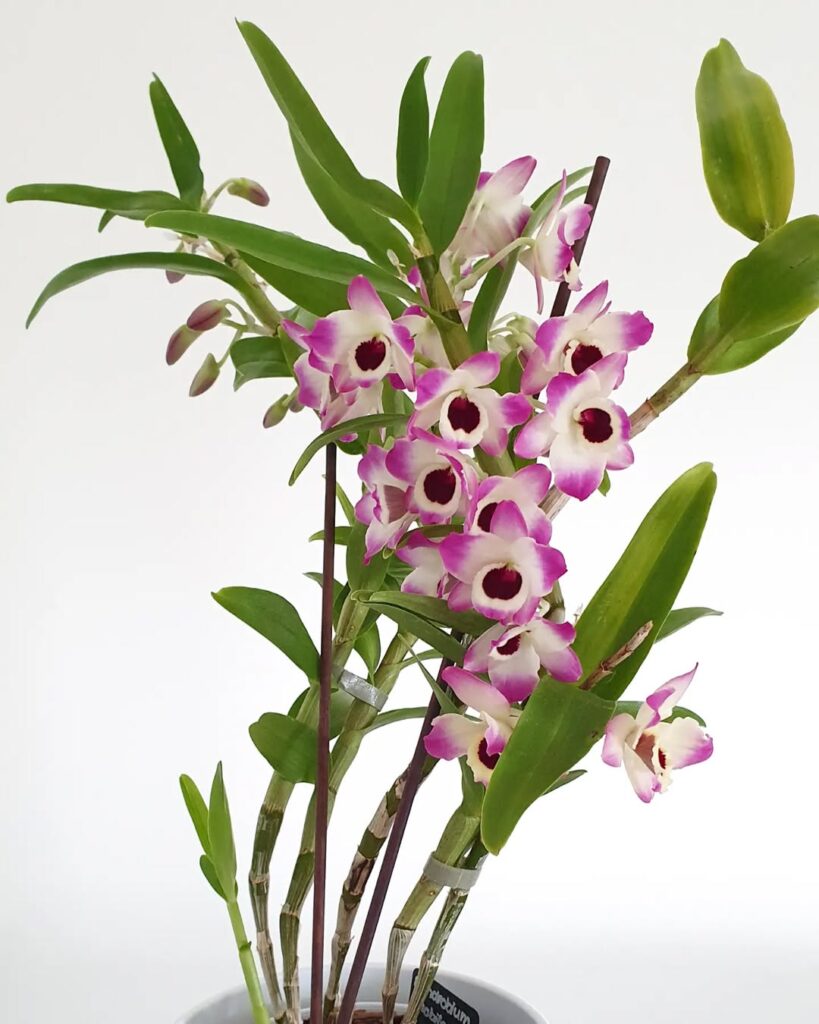
The Noble Dendrobium (Dendrobium nobile) is a popular orchid species known for its stunning clusters of fragrant flowers that bloom along its canes in late winter to early spring. Each flower features white to purple petals with a contrasting dark throat, and the blooms can last several weeks when properly maintained. Native to Southeast Asia, this orchid is considered one of the easier Dendrobium species to grow, making it suitable for both beginners and experienced growers.
- Light: Bright, indirect sunlight; morning sun is beneficial, but protect from intense afternoon sun
- Temperature: Day temperatures 65-75°F (18-24°C); night temperatures 55-60°F (13-16°C)
- Water: Weekly during growing season, reduced during winter rest period
- Humidity: 50-60%
- Soil: Well-draining orchid mix with bark, perlite, and charcoal
- Fertilizer: Balanced orchid fertilizer every 2 weeks during growing season
- Potting: Clay or plastic pots with plenty of drainage holes
- Rest Period: Requires cool, dry period in winter to initiate blooming
- Air Circulation: Good airflow around roots and leaves to prevent disease
3. Dancing Lady Orchid
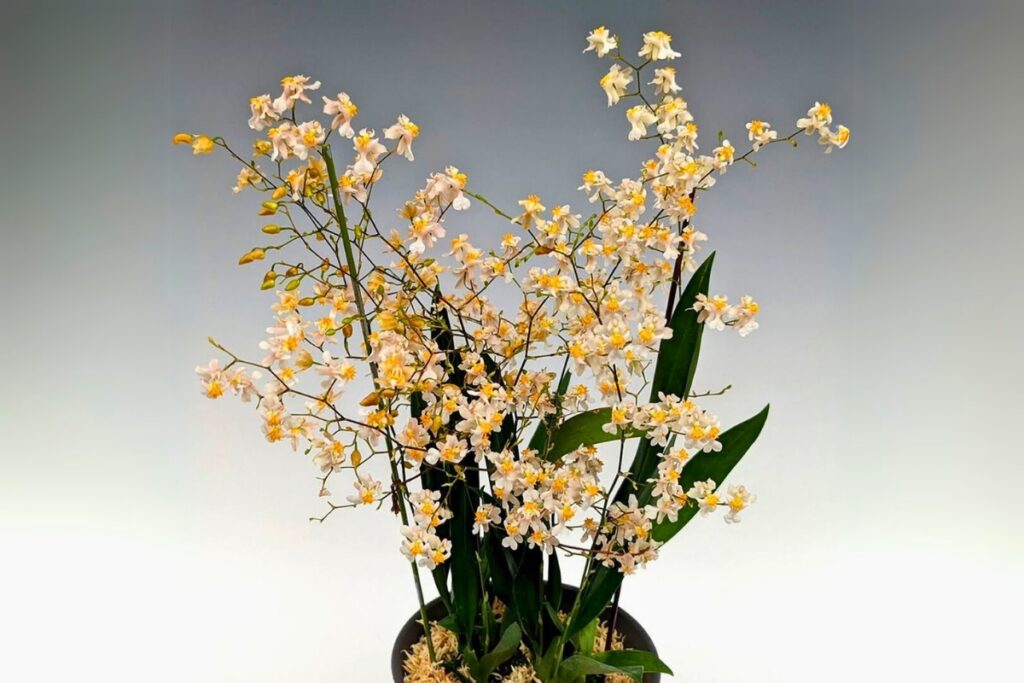
The Dancing Lady Orchid (Oncidium) gets its name from its unique flowers that appear to be dancing in the breeze, with bright yellow blooms featuring ruffled petals and distinctive “skirt-like” lips. These epiphytic orchids produce multiple branching flower spikes that can hold dozens of small flowers, creating a cascading display of color. Native to tropical and subtropical regions of the Americas, Dancing Lady Orchids are popular among home growers due to their adaptability and long-lasting blooms.
- Light: Bright, indirect sunlight; morning sun is ideal but protect from harsh afternoon sun
- Temperature: 55-85°F (13-29°C), with a 10-15°F drop at night
- Humidity: 50-70%
- Water: Allow top inch of medium to dry between waterings; reduce watering in winter
- Growing Medium: Well-draining orchid mix with bark, perlite, and charcoal
- Fertilizer: Balanced orchid fertilizer every 2-3 weeks during growing season
- Potting: Use containers with adequate drainage; repot every 2-3 years
- Air Circulation: Good airflow around roots and leaves to prevent rot
4. Elegant Cattleya Orchid
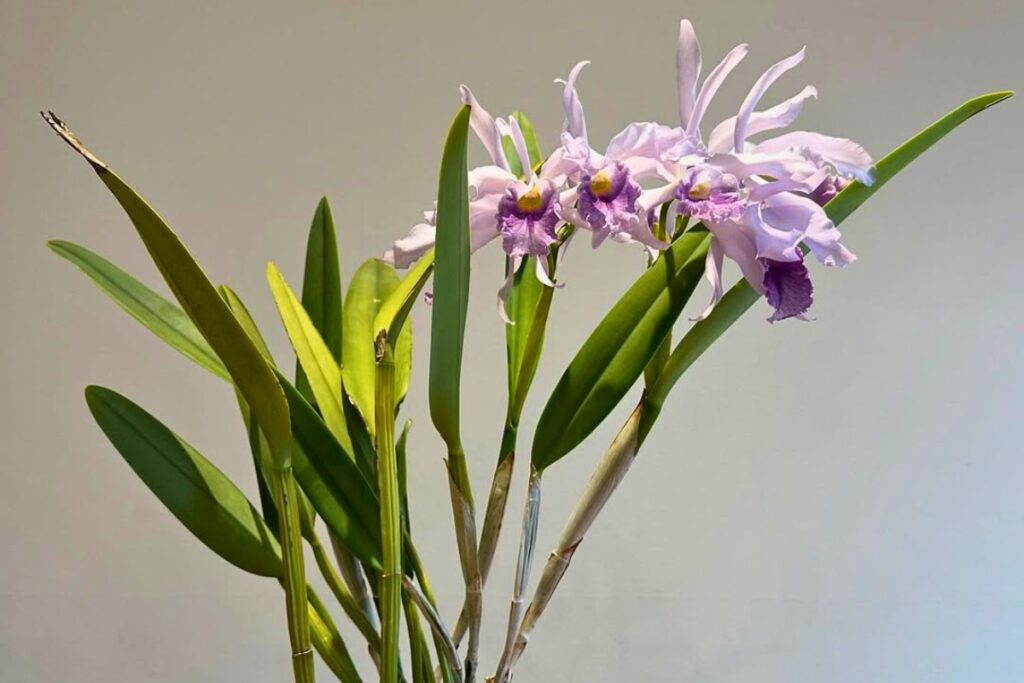
The Cattleya orchid, often called the “Queen of Orchids,” is renowned for its large, showy blooms and intense fragrance. These stunning epiphytic orchids produce vibrant flowers in shades of purple, pink, white, red, and yellow, with many featuring unique color combinations and patterns. Each bloom can measure up to 8 inches across and typically appears on tall stems rising from thick, cylindrical pseudobulbs. Cattleyas are particularly valued for their use in corsages and as indoor ornamental plants, blooming once or twice per year with flowers lasting several weeks.
- Light: Bright, indirect sunlight; morning sun is ideal; protect from intense afternoon sun
- Water: Allow potting medium to dry slightly between waterings; reduce watering in winter
- Temperature: 65-80°F (18-27°C) during day; 55-65°F (13-18°C) at night
- Humidity: 50-70%; use humidity trays or misting to maintain moisture
- Soil: Well-draining orchid mix with bark, perlite, and charcoal
- Fertilizer: Balanced orchid fertilizer every 2-3 weeks during growing season
- Potting: Use clay or plastic pots with plenty of drainage holes
- Air circulation: Good air movement required to prevent fungal issues
5. Lady Slipper Pink Orchid
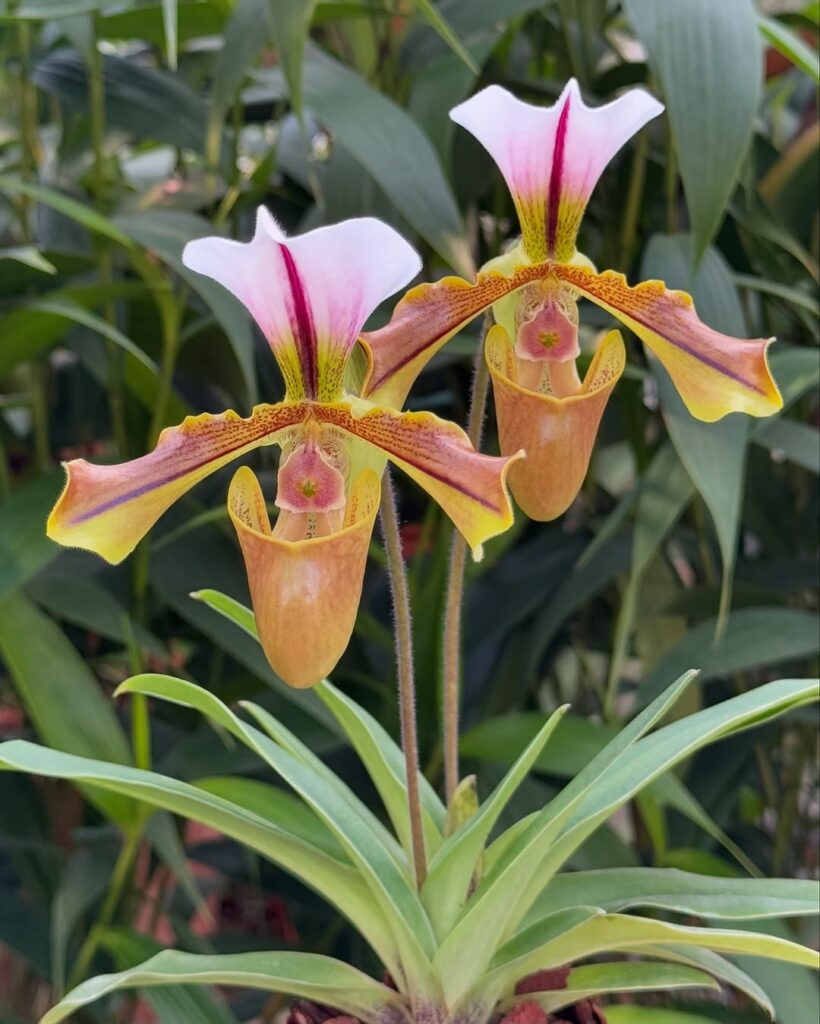
The Lady Slipper Pink Orchid (Paphiopedilum) is a striking terrestrial orchid known for its distinctive pouch-shaped lip that resembles a dainty slipper, typically in shades of pink. This orchid variety features mottled, leathery leaves and produces long-lasting blooms that can remain vibrant for several months. Native to tropical and subtropical Asia, these orchids have become popular among indoor growers due to their unique appearance and relatively manageable care requirements.
- Light: Moderate to bright indirect light; avoid direct sunlight; east or west-facing windows are ideal
- Water: Keep soil consistently moist but not waterlogged; water thoroughly when top inch of medium feels dry
- Humidity: 50-60% relative humidity; use humidity trays or humidifiers if needed
- Temperature: 60-85°F (15-29°C); can tolerate slight temperature fluctuations
- Growing Medium: Well-draining mix of fine bark, perlite, and sphagnum moss
- Fertilizer: Feed weekly with balanced, water-soluble fertilizer at quarter strength during growing season
- Repotting: Every 1-2 years when medium breaks down or roots outgrow pot
6. Fragrant Spider Orchid
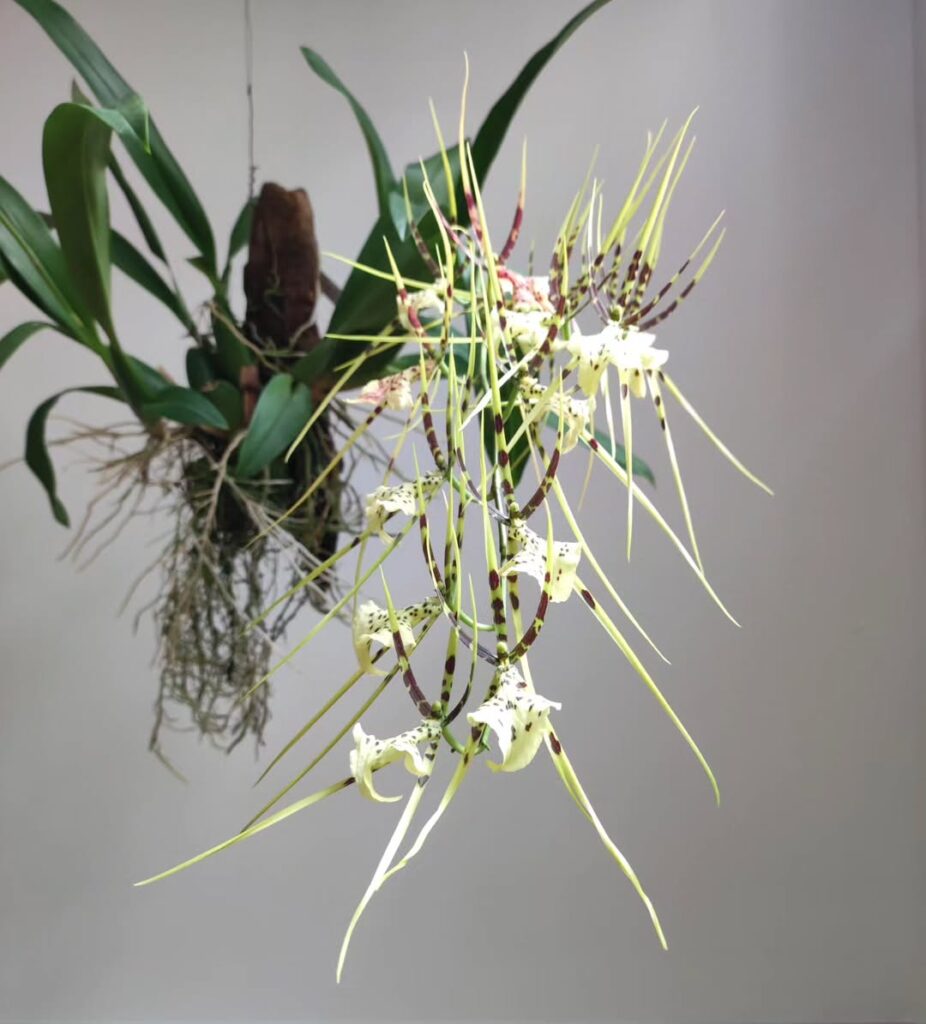
The Fragrant Spider Orchid (Brassia verrucosa) is known for its distinctive star-shaped flowers with long, thin sepals and petals that resemble a spider’s legs, stretching up to 6-8 inches across. These elegant orchids produce multiple cream-colored to pale green blooms adorned with dark brown spots, emanating a sweet vanilla-like fragrance that’s most intense during the evening hours. Each flowering stem can produce 6-12 flowers, blooming primarily during spring and summer months.
- Light: Bright indirect light; avoid direct sunlight except for early morning or late afternoon
- Temperature: 60-80°F (16-27°C) during day, with 10-15°F drop at night
- Humidity: 50-70%
- Water: Allow top inch of medium to dry between waterings; reduce watering in winter
- Growing Medium: Well-draining epiphytic mix with bark, charcoal, and perlite
- Fertilizer: Balanced orchid fertilizer at quarter strength every 2-3 weeks during growing season
- Air Movement: Good circulation required to prevent fungal issues
- Repotting: Every 2-3 years when new growth begins
7. Vanda Blue Magic Orchid
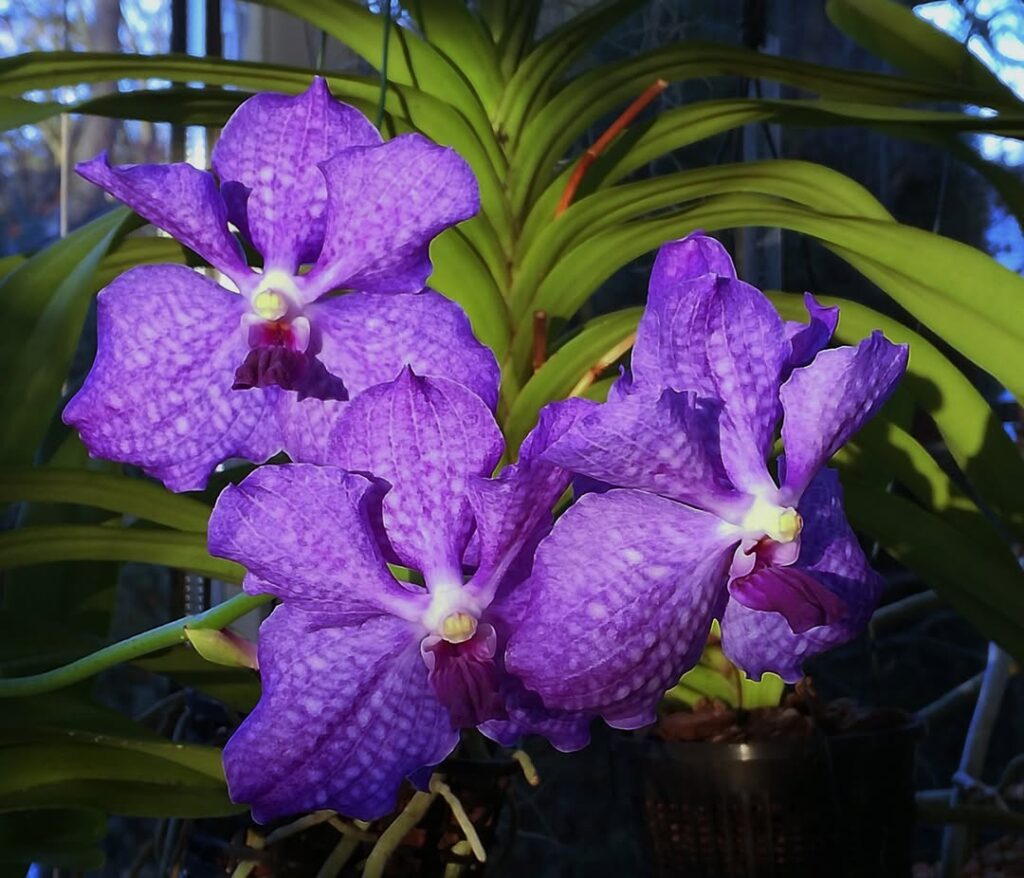
The Vanda Blue Magic orchid is a striking hybrid variety known for its deep blue-violet blooms and robust growth habit. This monopodial orchid produces multiple flower spikes with large, flat flowers that can reach up to 5 inches across. The blooms typically appear several times throughout the year and can last 2-3 weeks. Its thick, leathery leaves grow in a fan-like pattern, and the plant can reach heights of up to 3 feet when mature.
- Light: Bright, indirect light with some direct morning sun; requires 4-6 hours of light daily
- Temperature: Warm conditions, 65-85°F (18-29°C)
- Humidity: High humidity (60-80%)
- Water: Daily watering during growing season; reduce in winter
- Growing Medium: Most successful when grown bare-root in wooden baskets or mounted
- Fertilizer: Weekly feeding during growing season with balanced orchid fertilizer
- Air Movement: Requires good air circulation around roots and leaves
- Repotting: Every 2-3 years or when medium breaks down
8. Dragon Mouth Orchid
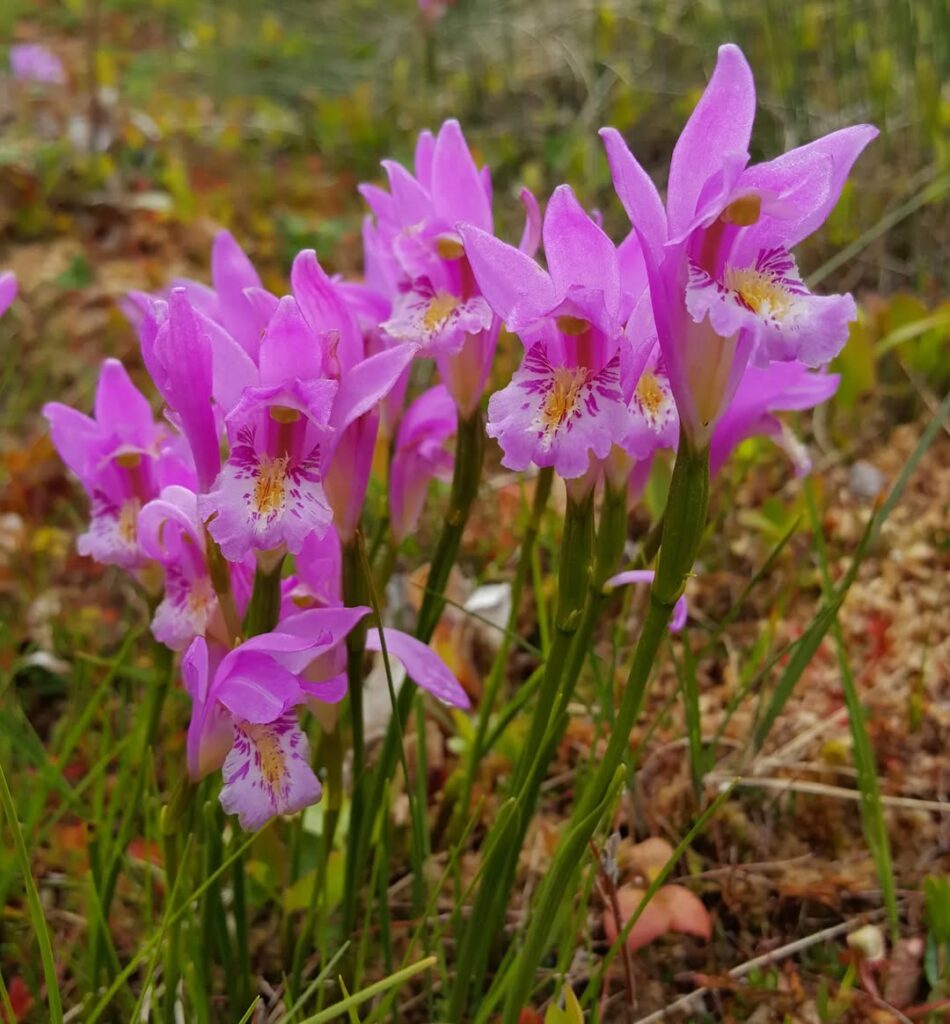
The Dragon Mouth Orchid (Arethusa bulbosa) is a rare, terrestrial orchid species native to North America’s wetlands and bogs. This petite orchid produces a single magenta-pink flower that resembles a dragon’s open mouth, blooming in late spring to early summer. The plant grows from a small corm and features a slender stem with a narrow, grass-like leaf that often appears after flowering. Standing only 4-8 inches tall, this orchid is considered threatened in many areas due to habitat loss and collection.
- Light: Partial shade to full sun, depending on natural habitat
- Water: Consistently moist soil, never allowing it to dry out completely
- Soil: Acidic, nutrient-poor soil with high organic matter content
- Temperature: Cool to moderate temperatures, 60-75°F (15-24°C)
- Humidity: High humidity levels, 60-80%
- Growing Medium: Sphagnum moss or specialized bog mix
- Growing Zone: USDA zones 3-7
- Propagation: Through division of corms or seed germination
- Winter Care: Requires winter dormancy period with cooler temperatures
9. Jewel Orchid’s Velvet Leaves

The Jewel Orchid stands out for its enchanting foliage rather than its flowers, featuring deep green leaves with distinctive metallic veining patterns that shimmer in light. These velvety leaves display intricate networks of gold, silver, or copper-colored stripes against their dark background, creating a striking ornamental effect. While the plant does produce small white or pink flowers on tall spikes, most enthusiasts cultivate this orchid specifically for its dramatic, jewel-like foliage.
- Light: Thrives in low to medium indirect light; avoid direct sunlight which can damage the delicate leaves
- Water: Keep soil consistently moist but not waterlogged; water when top inch of soil feels dry
- Soil: Well-draining, organic potting mix rich in humus; mix orchid bark with regular potting soil
- Humidity: Requires 60-80% humidity; use humidity trays or mist regularly
- Temperature: Prefers warm conditions between 65-80°F (18-27°C)
- Fertilizer: Feed monthly with balanced, water-soluble fertilizer at quarter strength
- Container: Plant in shallow pots with adequate drainage holes
10. Miniature Masdevallia Orchid Blooms
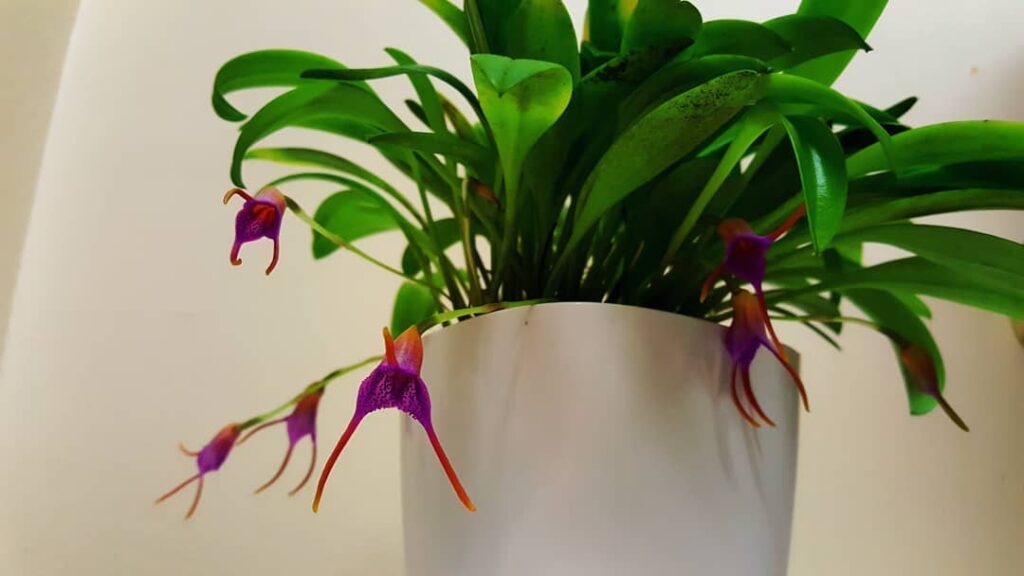
Masdevallia orchids are known for their petite, triangular-shaped blooms that often resemble tiny colorful birds in flight. These miniature flowers, typically measuring 1-3 inches across, emerge from compact plants and feature distinctive sepals that extend into long, delicate tails. The blooms come in vibrant colors including orange, red, yellow, purple, and white, often with intricate patterns or spots, and can appear singularly or in small clusters throughout the year, depending on the species.
- Light: Bright, indirect light; protect from direct sun; ideal for east or north-facing windows
- Temperature: Cool to intermediate conditions; 60-75°F (15-24°C) during day, 50-60°F (10-15°C) at night
- Humidity: High humidity (60-80%); requires regular misting or humidity trays
- Water: Keep consistently moist but not waterlogged; water when top layer begins to dry
- Growing Medium: Fine-grade, well-draining mix of sphagnum moss, fine bark, and perlite
- Fertilizer: Weekly feeding with balanced, water-soluble fertilizer at quarter strength
- Air Movement: Good circulation required to prevent fungal issues
- Container: Small pots with adequate drainage; plastic or clay pots suitable
11. Bamboo Orchid’s Narrow Stems
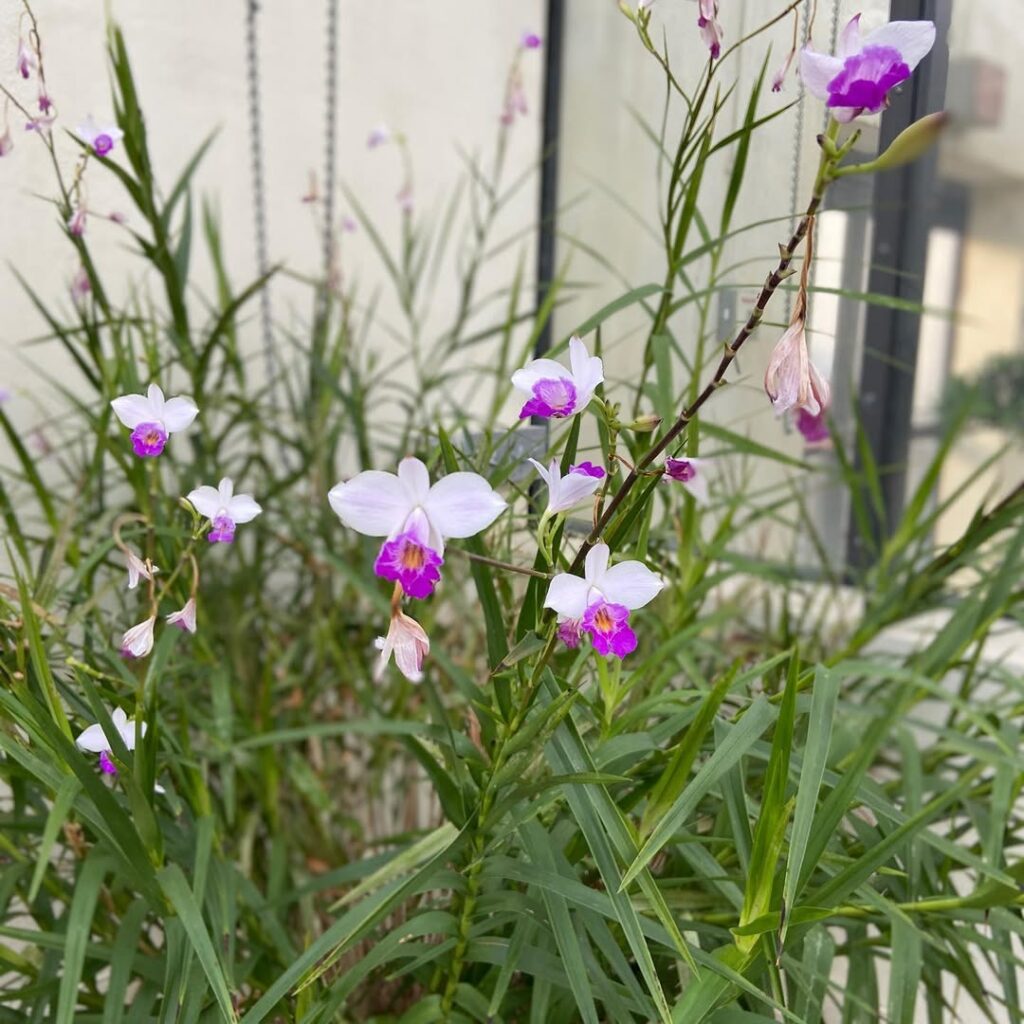
The bamboo orchid‘s narrow stems are a distinctive feature that gives this orchid variety its common name, as they closely resemble bamboo in appearance. These tall, reed-like stems grow in clusters and can reach heights of 4-6 feet, maintaining their slender profile throughout their growth. The stems are typically light green to yellowish-green in color, with visible nodes along their length, and they provide strong support for the plant’s leaves and flowering spikes.
- Light: Bright, indirect sunlight; can tolerate some direct morning sun
- Water: Keep consistently moist but not waterlogged; water when top inch of soil feels dry
- Soil: Well-draining orchid mix with added bark and perlite
- Humidity: 50-70% relative humidity
- Temperature: 65-85°F (18-29°C)
- Fertilizer: Balanced orchid fertilizer every 2-4 weeks during growing season
- Container: Well-ventilated pot with adequate drainage holes
- Air Circulation: Good airflow around stems to prevent fungal issues
12. Gold Cup Orchid
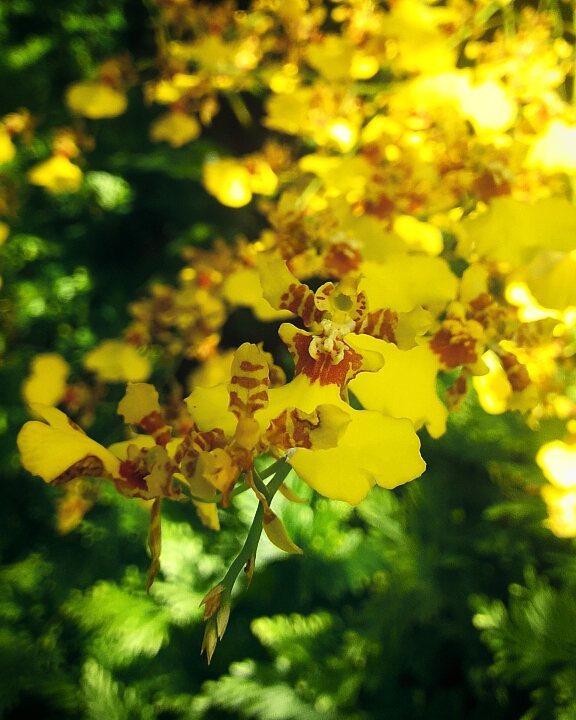
The Gold Cup Orchid (Oncidium excavatum) is a striking epiphytic orchid species native to South America, particularly Peru and Ecuador. Known for its bright yellow flowers with brown spotting, this orchid produces large sprays of blooms that can contain up to 100 flowers per spike. The flowers typically appear in winter to spring, creating a spectacular display that can last for several weeks. Its common name comes from the distinctive cup-shaped lip of each flower, which appears golden in color.
- Light: Bright indirect light; morning sun is beneficial but protect from intense afternoon sun
- Temperature: Warm to intermediate conditions; 60-85°F (15-29°C)
- Humidity: 50-70%
- Water: Allow medium to dry slightly between waterings; reduce watering in winter
- Potting Medium: Well-draining orchid mix with bark, charcoal, and perlite
- Fertilizer: Balanced orchid fertilizer every 2-3 weeks during growing season
- Container: Clay or plastic pot with adequate drainage holes
- Air Circulation: Good air movement required to prevent fungal issues
13. Orange Butterfly Orchid

The Orange Butterfly Orchid (Psychopsis papilio) is a striking epiphytic orchid known for its distinctive butterfly-shaped blooms in vibrant orange, yellow, and reddish-brown patterns. Native to Trinidad and South America, this orchid features a single leaf per pseudobulb and produces long-lasting flowers on tall, wiry stems that can rebloom multiple times from the same spike. The flower’s unique shape, with elongated petals resembling butterfly wings, makes it a popular choice among orchid enthusiasts.
- Light: Bright, indirect light; morning sun is acceptable but protect from harsh afternoon sun
- Temperature: Warm growing, 65-85°F (18-29°C)
- Humidity: 60-80%
- Water: Allow to dry slightly between waterings; reduce watering in winter
- Potting Medium: Well-draining orchid mix with bark, charcoal, and perlite
- Fertilizer: Balanced orchid fertilizer every 2-3 weeks during growing season
- Mounting: Can be grown mounted on bark or in pots
- Air Movement: Requires good air circulation to prevent root rot
- Repotting: Every 2-3 years when media breaks down or roots outgrow container
14. Variegated Vanilla Orchid
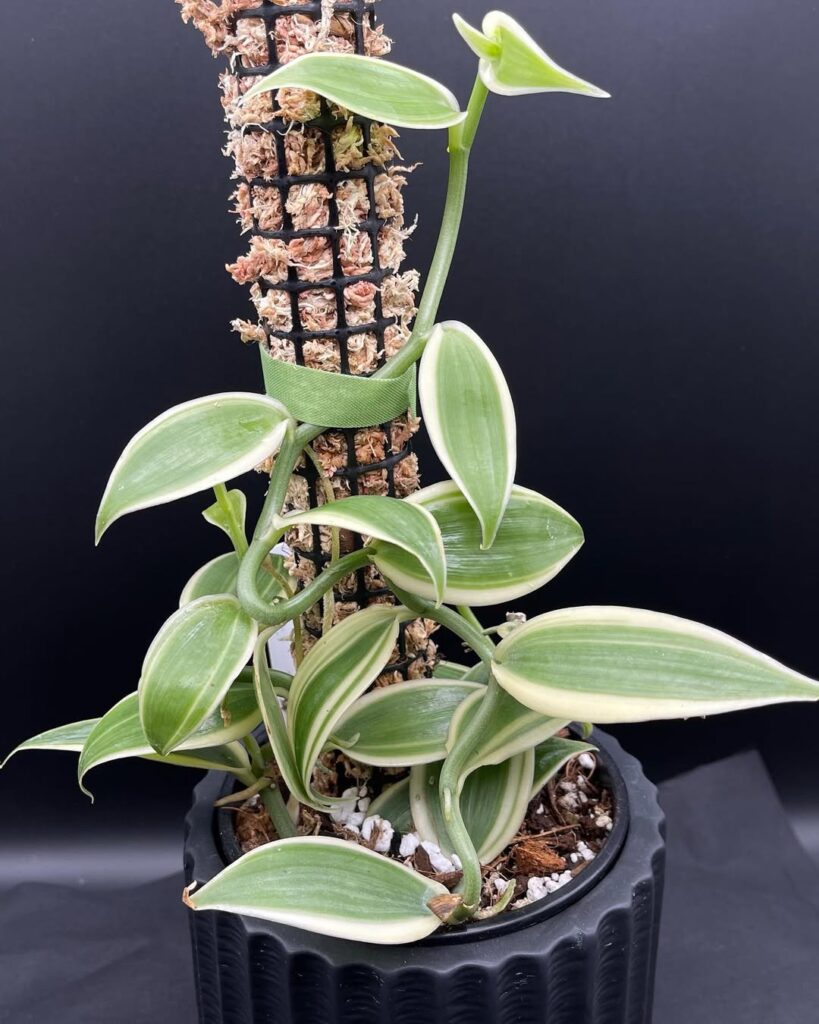
The variegated Vanilla Orchid (Vanilla planifolia) features cream-colored stripes along its green leaves. As a climbing vine orchid, it can reach lengths of 20-30 feet when mature and produces the same vanilla beans as its non-variegated parent species. This variety is particularly prized by collectors for its ornamental foliage, though it requires more specific care than the standard vanilla orchid due to its variegation.
- Light: Bright, indirect light; protect from direct afternoon sun; morning sun is acceptable
- Temperature: 70-85°F (21-29°C) during day, no lower than 60°F (15°C) at night
- Humidity: 60-80%
- Water: Keep consistently moist but not waterlogged; reduce watering in winter
- Growing Medium: Well-draining orchid mix with chunks of bark, charcoal, and sphagnum moss
- Support: Requires sturdy support structure for climbing
- Fertilizer: Feed weekly with balanced orchid fertilizer at quarter strength during growing season
- Air Circulation: Good air movement required to prevent fungal issues
15. Miltonia Sunset Orchid
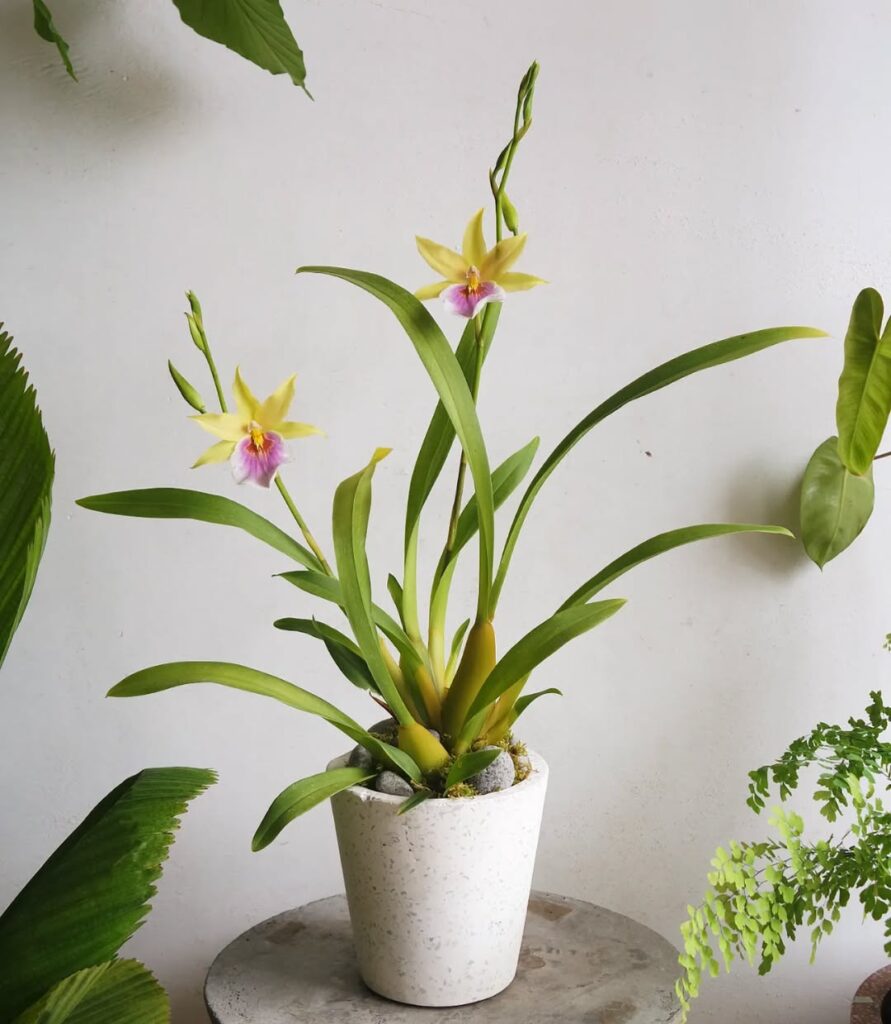
The Miltonia Sunset orchid is a striking hybrid variety known for its large, pansy-like blooms in warm sunset colors ranging from golden yellow to deep orange-red with purple undertones. These fragrant flowers typically appear in spring and summer, lasting several weeks when properly maintained. The plant features slim pseudobulbs and long, narrow leaves, typically growing to around 12-18 inches in height, making it a manageable size for indoor cultivation.
- Light: Bright indirect light; protect from direct afternoon sun; east or north-facing windows ideal
- Temperature: 65-75°F (18-24°C) during day; 55-65°F (13-18°C) at night
- Humidity: 50-70%; use humidity tray or humidifier if needed
- Water: Keep consistently moist but not soggy; water when top inch of media feels dry
- Growing Medium: Well-draining mix of fine bark, perlite, and sphagnum moss
- Fertilizer: Balanced orchid fertilizer (20-20-20) applied weekly at quarter strength during growing season
- Repotting: Every 1-2 years when media breaks down or after flowering
- Air Movement: Good circulation required to prevent fungal issues
